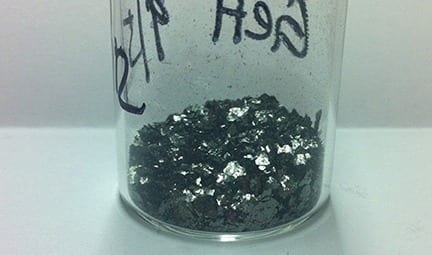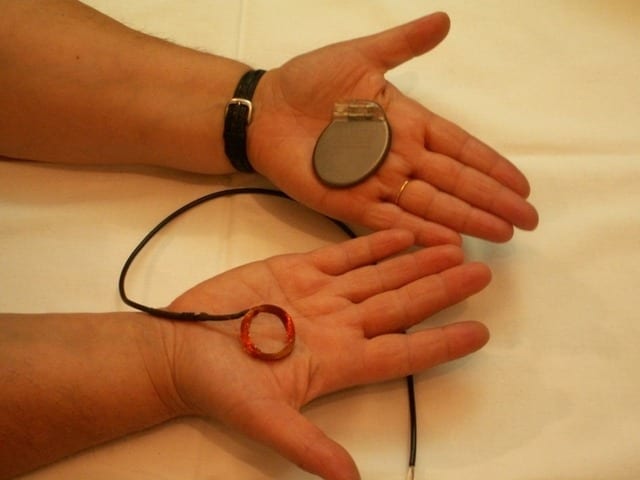
Thin Layer of Germanium May Replace Silicon in Semiconductors
The same material that formed the first primitive transistors more than 60 years ago can be modified in a new way to advance future electronics, according to a new study.
Chemists at The Ohio State University have developed the technology for making a one-atom-thick sheet of germanium, and found that it conducts electrons more than ten times faster than silicon and five times faster than conventional germanium.
The material’s structure is closely related to that of graphene—a much-touted two-dimensional material comprised of single layers of carbon atoms. As such, graphene shows unique properties compared to its more common multilayered counterpart, graphite. Graphene has yet to be used commercially, but experts have suggested that it could one day form faster computer chips, and maybe even function as a superconductor, so many labs are working to develop it.
Joshua Goldberger, assistant professor of chemistry at Ohio State, decided to take a different direction and focus on more traditional materials.
“Most people think of graphene as the electronic material of the future,” Goldberger said. “But silicon and germanium are still the materials of the present. Sixty years’ worth of brainpower has gone into developing techniques to make chips out of them. So we’ve been searching for unique forms of silicon and germanium with advantageous properties, to get the benefits of a new material but with less cost and using existing technology.”
In a paper published online in the journal ACS Nano, he and his colleagues describe how they were able to create a stable, single layer of germanium atoms. In this form, the crystalline material is called germanane.
Researchers have tried to create germanane before. This is the first time anyone has succeeded at growing sufficient quantities of it to measure the material’s properties in detail, and demonstrate that it is stable when exposed to air and water.
The Latest Bing News on:
Germanium
- Ivanhoe Mines Issues 2024 First Quarter Financial Results, and Overview of Construction and Exploration Activitieson April 30, 2024 at 4:30 am
Kamoa-Kakula sold 85,155 tonnes of payable copper during the quarter and recognized revenue of $618 million, as well as EBITDA of $365 millionIvanhoe Mines recorded Q1 2024 loss of $69 million, ...
- Ivanhoe Mines Announces Redemption of $575 Million 2.50% Convertible Senior Notes Due 2026on April 30, 2024 at 4:29 am
Ivanhoe will reduce debt to below $150 million following redemption of the convertible notesVancouver, British Columbia--( - April 30, 2024) - Ivanhoe Mines (TSX: IVN) (OTCQX: IVPAF) ("Ivanhoe Mines" ...
- Teck Resources (TECK): New Buy Recommendation for This Basic Materials Gianton April 29, 2024 at 9:05 am
Raymond James analyst Brian MacArthur maintained a Buy rating on Teck Resources (TECK – Research Report) today and set a price target of ...
- Scientists at the MAJORANA Collaboration look for rule-violating electronson April 24, 2024 at 5:10 am
In a new study published inNature Physics, scientists at the MAJORANA Collaboration have tested the stringency of charge conservation and Pauli's exclusion principles using underground detectors.
- New law requires telework option for pregnant workerson April 23, 2024 at 10:02 am
The Pregnant Workers Fairness Act requires agencies to provide reasonable accommodations, from longer breaks to telework.
- China's March germanium, gallium exports yet to recover year-ago levelon April 21, 2024 at 6:55 pm
China's exports of gallium and germanium products in March declined from year-ago levels, customs data showed on Saturday, underlining the impact of export controls in place since last August. China ...
- China's March Germanium, Gallium Exports Yet to Recover Year-Ago Levelon April 19, 2024 at 6:33 pm
BEIJING (Reuters) - China's exports of gallium and germanium products in March declined from year-ago levels, customs data showed on Saturday, underlining the impact of export controls in place ...
- Chemistry in its element: germaniumon October 22, 2019 at 10:50 am
If there were a competition for the chemical element mostly likely to generate schoolboy howlers, the winner should be germanium. It's inevitable that the substance with atomic number 32 is quite ...
- Germanium Comes of Ageon June 24, 2017 at 10:18 am
One of the graduate students, Seymour Benzer, accidentally discovered that a crystal of germanium -- a semiconductor which was not well understood at the time -- could withstand higher voltage ...
- Germanium, Geon November 27, 2014 at 6:14 am
Germanium is a semiconductor in group IVA of the periodic table. It has an atomic number of 32, an atomic weight of 72.59, and a density of 5.32 Mg/m 3. Its melting temperature is 937.4 C. Germanium ...
The Latest Google Headlines on:
Germanium
[google_news title=”” keyword=”germanium” num_posts=”10″ blurb_length=”0″ show_thumb=”left”] [/vc_column_text]The Latest Bing News on:
Thin film germanium
- Film Clubon April 25, 2024 at 7:51 am
By Jeremy Engle and Michael Gonchar How to use our weekly Film Club feature to teach close reading and critical thinking skills via an eclectic mix of nonfiction videos. By Jeremy Engle ...
- New research demonstrates potential of thin-film electronics for flexible chip designon April 24, 2024 at 8:00 am
The mass production of conventional silicon chips relies on a successful business model with large "semiconductor fabrication plants" or "foundries." New research by KU Leuven and imec shows that this ...
- Opening up the potential of thin-film electronics for flexible chip designon April 23, 2024 at 5:00 pm
The mass production of conventional silicon chips relies on a successful business model with large 'semiconductor fabrication plants' or 'foundries'. New research by shows that this 'foundry' model ...
- New photovoltaic 2D material breaks quantum efficiency recordon April 22, 2024 at 4:59 pm
Solar sandwich: Schematic of the thin-film solar cell with CuxGeSe/SnS as the active layer ... The team made the new compound by inserting copper atoms between atomically thin layers of germanium ...
- First Solar, ZSW to develop thin-film, CIGS and perovskite technologyon April 22, 2024 at 7:07 am
US cadmium telluride (CdTe) thin-film solar manufacturer First Solar has agreed to pursue further thin-film technology development with ZSW.
- ZSW and First Solar announce research partnership on thin film PVon April 21, 2024 at 10:13 am
ZSW is a research institute with over 30 years of experience and knowledge in the field of thin film photovoltaics. Since its foundation, the main objective has been on materials development and ...
- ZSW, First Solar partner to collaborate on thin-film PVon April 19, 2024 at 6:00 am
Württemberg (ZSW) and First Solar have agreed to work together to develop thin-film PV technologies on a gigawatt scale.
- Comprehensive model unravels quantum-mechanical effects behind photoluminescence in thin gold filmson April 18, 2024 at 5:00 pm
More information: Alan R. Bowman et al, Quantum-mechanical effects in photoluminescence from thin crystalline gold films, Light: Science & Applications (2024). DOI: 10.1038/s41377-024-01408-2 ...
- Everything You Need To Know About Thin Film Solar Panelson April 17, 2024 at 10:32 am
Thin film solar panels are composed of solar cells that are much slimmer than the average solar panel. They are also more flexible, weigh less, and are easier to install. There are four basic ...
- New quantum solar cell material promises external quantum efficiency of 190%on April 10, 2024 at 5:00 pm
It consists of an heterostructure combining germanium (Ge), selenium (Se), and ... With it, the group designed and modeled a thin-film solar cell with the proposed material as the active layer.
The Latest Google Headlines on:
Thin film germanium
[google_news title=”” keyword=”thin film germanium” num_posts=”10″ blurb_length=”0″ show_thumb=”left”]









